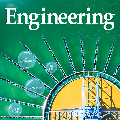Many complex engineering systems can be represented in a topological form, such as graphs. This paper utilizes a machine learning technique called Geometric Deep Learning (GDL) to aid designers with challenging, graph-centric design problems. The strategy presented here is to take the graph data and apply GDL to seek the best realizable performing solution effectively and efficiently with lower computational costs. This case study used here is the synthesis of analog electrical circuits that attempt to match a specific frequency response within a particular frequency range. Previous studies utilized an enumeration technique to generate 43,249 unique undirected graphs presenting valid potential circuits. Unfortunately, determining the sizing and performance of many circuits can be too expensive. To reduce computational costs with a quantified trade-off in accuracy, the fraction of the circuit graphs and their performance are used as input data to a classification-focused GDL model. Then, the GDL model can be used to predict the remainder cheaply, thus, aiding decision-makers in the search for the best graph solutions. The results discussed in this paper show that additional graph-based features are useful, favorable total set classification accuracy of 80\% in using only 10\% of the graphs, and iteratively-built GDL models can further subdivide the graphs into targeted groups with medians significantly closer to the best graph and containing 87 of the top 100 best performing graphs.
翻译:许多复杂的工程系统可以用拓扑形式,即图表达。本文利用一种名为几何深度学习(GDL)的机器学习技术来解决图为中心的设计问题。本文策略是将图数据应用于GDL,以寻找最佳的可实现性能解决方案,并且具有较低的计算成本。本文研究的案例是合成模拟电路,试图在特定频率范围内匹配特定频率响应。以前的研究采用枚举技术生成43,249个独特的无向图形式的有效潜在电路。然而,确定许多电路的尺寸和性能可能过于昂贵。为了降低计算成本并在精度上有量化的权衡,本文使用电路图的比例和其性能作为输入数据来训练以分类为重点的GDL模型。然后,GDL模型可以便宜地预测剩余部分,从而帮助决策者寻找最佳图形解决方案。本文讨论的结果表明,额外的基于图形的功能是有用的,仅使用10%的图形即可获得有利的总集分类准确性80%,并且迭代构建的GDL模型可以将图形进一步划分为目标组,其中中位数与最佳图形显著更接近,并包含前100个最佳性能图形的87个。



